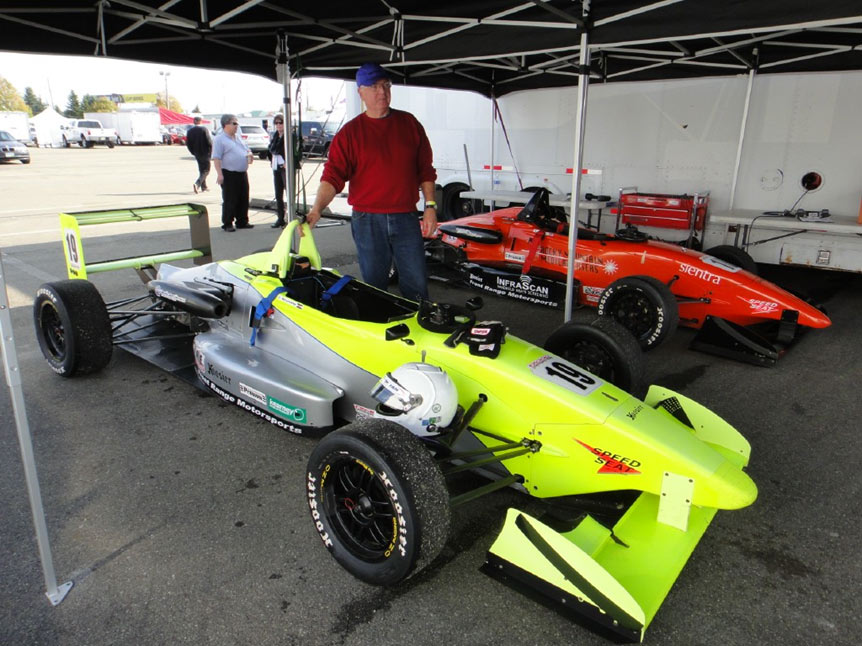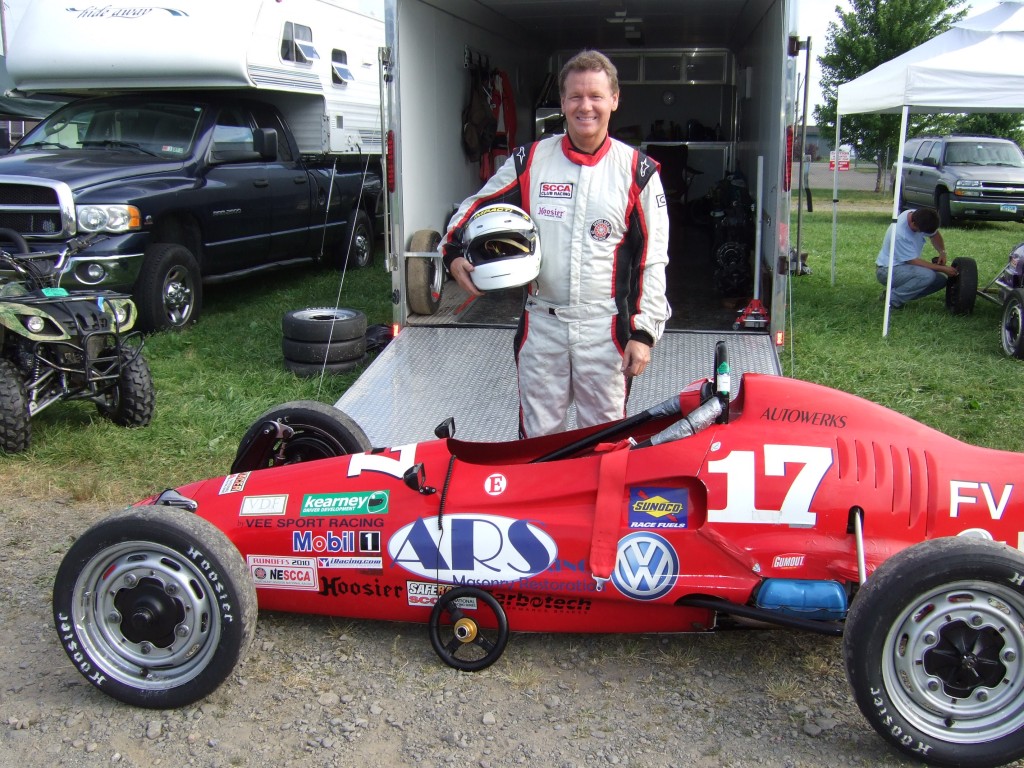
A Noble trifecta at IRP. Bill liked to win but he also loved to see his guys do well. Good times with Jim Kearney, Bill Nobel, and Jeff Loughead

Driver Coaching: Applying 32 Years of Experience. Jim Kearney in the Front Range Motorsports Compound at the Pro F2000 Race – Watkins Glen, October, 2012
My Background
- 32 Years Formula Vee racing, plus, F/Ford, F2000 and SSC
- 22 Runoffs appearances, 9 top 10 finishes: ’91 Silver medal, ’96 Bronze
- 1992 Valvoline Pro Vee Champion
- 1994 Jerry Knapp Award
- Northeast F/V Divisional Champion – 4 times
How I Work
- Establish a simple plan for each session.
- Observe selected critical areas and take segment times.
- Review track map and/or debrief sheet immediately after each session.
- Debrief shortly afterward, followed by in-car camera review, if available.
Pre – Event Conference Call
A 30 minute phone call a week before an event can go a long way to get everyone on the same page. Some drivers like to have crew members participate as well.
Coach v. Instructor. An instructor tells you what to do and how to do it. A coach looks for things you are ready to work on and acts as a guide to bring out your best. Everybody is different. It doesn’t always take effect right away. When we first worked together Craig Clawson turned to me after a session and said, “I knew just what you wanted me to do but I didn’t do it.” I told him he had taken the first step. This is a complex process and you can’t hurry your mind. By the next day Craig had lopped off 1.8 seconds off his personal best lap time and gridded 8th of 32 cars at Watkins Glen in the intense Pro F2000 Championship Series.
Why I Coach – It Is My 12 Step Program
“I can talk to these other guys all day long; you put it in words that I can understand.” – Ray Qualls
When I sold my racing equipment many drivers thanked me for my help over the years. I thought they just were being nice. I called four drivers and asked them if they would be interested in hiring me to be their driver coach at the upcoming Runoffs. All four said yes. I was back at the races.
My debut as a coach: A National Championship! – 2010 National Runoffs – Road America, Wisconsin. One of my first customers was Rick Shields, whose prior best Runoffs finish in four tries was ninth. Rick not only won the National Championship in Formula Vee, he was selected by the SCCA as the Club’s Most Improved Driver of 2010. He received the Kimberly Cup in Las Vegas at the National Convention.
 “In my wildest dreams, I never thought I’d win this race. Jim helped me tap into an incredible amount of information. I’ll definitely use his coaching services again. Before Jim, the best I could do at the Runoffs was 9th.”- Rick Shields, 2010 F/V National Champion, Kimberly Cup Winner – Most Improved Driver of the Year.
“In my wildest dreams, I never thought I’d win this race. Jim helped me tap into an incredible amount of information. I’ll definitely use his coaching services again. Before Jim, the best I could do at the Runoffs was 9th.”- Rick Shields, 2010 F/V National Champion, Kimberly Cup Winner – Most Improved Driver of the Year.
Ray Phillips went 3 seconds faster than his prior best time at Road America. Ray had a strong performance going at the 2010 Runoffs until he got caught out in a huge oil spill. Ray didn’t have a ton of national F/V experience. He had only been to the Runoffs once before and was 16th at Topeka in 2007. We set a goal to qualify in the top 20 and finish in the top 10. and gridded 17th of 38 cars. In only three laps he charged up to 13th on his way to a top 10 finish when he spun in a huge oil slick that took out many cars.
In the Beginning – An Inadvertent Coach – Summit Point, July, 2009
In 2009 I went to Summit Point to help my pal Guy Pipitone who was running a Formula Mazda series. I expected to simply crew for Guy but he needed more. He said, “I think I’ve lost it.” At both Mid-Ohio and Road America he’d been mired in the middle teens. I reverted to my days as an SCCA Driver’s School instructor. I walked Guy out to Turn 10 and we picked a turn in point. We would select one or two things to work on each session and we’d debrief immediately afterward. We worked our way around the track.
On Saturday morning Guy qualified on the Pole with a lap that was .3 seconds below the track record. We talked about the myriad of things that affect a racing outcome: tire management, strategy, the weather, the schedule. Guy led the first eight laps of the race before missing a shift. Still, he came home third and felt rejuvenated. I’d had my first coaching experience. It felt good to share some of my experience. It was a way for me to compete.
The Basic Problem: Drivers Are Overwhelmed – Too Many Tasks, Not Enough Time
It is easy to overlook the multitude of things you must handle just to get on the track. Your real job, the racecar, the tow vehicle, the trailer, motels etc. Most club races simply have way too much to do. Sometimes the only real chance you have to objectively analyze your driving is on the way home. There has to be a better way.
The Solution: Impose Order Over the Chaos – Two Heads Are Better Than One
Having a plan is a critical step in an organized approach. What issue is impeding the driver the most? I start with what the driver wants to work on first. Usually we start on the basics: establish solid points and hitting those marks consistently. Then we go for more speed. The issue may be braking performance, handling traffic or drafting. Drivers almost always have a sense of their weak points.
- I Tune the Helmet. I’m not a chassis guy. My focus is on the driver. As a legal aid lawyer, I spent a lot of time dealing with people under stress.
- I Think Like a Driver. When I raced I read a lot about the mental side of the sport. I found a way to win: be organized, be disciplined and be ready early. This gives you time to think about your driving. As Yogi Berra says, “90% of this game is half mental.”
